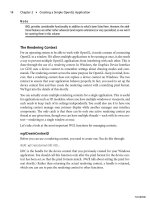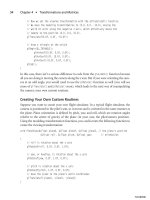PHP Game Programming 2004 phần 8 pptx
Bạn đang xem bản rút gọn của tài liệu. Xem và tải ngay bản đầy đủ của tài liệu tại đây (588.9 KB, 38 trang )
250 Chapter 11
■
Kiddy Cartel—Creating Your Own MMO
class CCommandFactory
{
// This exists in order to allow the parent
// reference in the commands to be set to null.
var $m_NullVariable = null;
function CreateCommand( $sCmdName = “” )
{
// if it’s a known class, create it
if (class_exists( $sCmdName ))
{
return new $sCmdName( $m_NullVariable );
}
// are we trying to create a class that doesn’t exist?
else if ( $sCmdName != “” && !class_exists( $sCmdName ) )
{
// this should never happen, so warn the programmer
// (they probably forgot to require_once the command)
echo “UNKNOWN COMMAND!<BR>”;
// hard exit, since there is nothing else we can really do
exit(1);
}
// it’s undefined, so go with the default
else
{
// render the main game command by default
return new CGameMenuCmd($this->m_NullVariable);
}
}
}
?>
If you create your own commands and forget to add the
require_once()
reference to the file
then the game will let you know that it is trying to execute an unknown command. So
remember to add your command to the command factory.
As you can see, all that the command factory does is check to see if the command that you
are trying to create exists. If the command does exist then it creates it; if the command
does not exist then it lets you know. If there is no command to execute then it assumes
that you are on the game menu and that it should render the menu to the browser.
Look at All the Commands. . . Now What? 251
So how in the world do you put all of this together? Well, that is where the
CGame()
class
comes into play. Everything that happens in the game occurs through the main.php page.
The main.php page calls the
CGame()
class. Take a look at the main.php page.
<?
require_once( “CGame.php” );
require_once( “CNeighborhood.php” );
require_once( “CCommand.php” );
require_once( “CRenderCmd.php” );
function main()
{
// seed the random number generator once for all commands
srand( time() );
// get the session up and running
session_start();
// if there isn’t a game objection in the session, make one
if ( !isset($_SESSION[‘game’]) )
{
$_SESSION[‘game’] = new CGame;
}
// execute the current game command
$_SESSION[‘game’]->ExecuteCommand( $_REQUEST );
}
main();
?>
The first event that occurs when you hit this page is that it checks to see if you currently
have a session. If you do have a session, then it executes any requests that have come
through the page by using the global
$_REQUEST
variable. However, if you do not have a ses-
sion it starts a new game by calling the
CGame()
class. Figure 11.4 shows the login screen of
the game, which is rendered when a session is started.
252 Chapter 11
■
Kiddy Cartel—Creating Your Own MMO
Figure 11.4 The login screen displays when a new game is started.
Once the main.php file constructs the
CGame()
class, the
CGame()
class constructs a new
command factory.
function CGame()
{
// create the factory that we will be using to get our comands
$this->m_CmdFactory = new CCommandFactory;
}
Once the command factory is loaded, the main.php file calls the
ExecuteCommand()
function
for the
CGame()
class. This function checks the query string to see if there are any com-
mands posted to it. If there are no commands posted to the
$_REQUEST
object then the com-
mand type is set to a blank string. This blank string tells the game to render the game
menu. Remember that the
$_REQUEST
object sends the type of command to the command
factory and if there aren’t any commands, it assumes that you are on the menu.
After the
CGame()
class checks to see if the
$_REQUEST
object is populated it credits the player
with the turns he deserves. Next it checks to see if a command is currently executing. If a
command is not executing then it attempts to create a new command.
If a command is executing then the
CGame()
class checks to see if the executing command
is the same as the command that was requested. If it is not the same then something weird
Look at All the Commands. . . Now What? 253
has happened and the executing command needs to be rolled back and the new requested
command needs to be created.
Once the command is created, it runs the command. After the command is run, it
checks the results that you defined earlier in the
Command()
class. If the result is equal to
CMD_FINISHED
it means that the command has completed successfully. Otherwise it checks
to see if an error has occurred. If an error has occurred the command has already rolled
back what it has attempted to do, so you just need to let the user know what happened.
The following code listing shows the
CGame()
class in all its fantastic glory:
<?
require_once( “CCommandFactory.php” );
require_once( “CNeighborhood.php” );
require_once( “CCreditTurns.php” );
class CGame
{
// the player’s neighborhood
var $m_Neighborhood;
// the currently executing command
var $m_CurrentCmd;
// the command factory from which to get all of our commands
var $m_CmdFactory;
function CGame()
{
// create the factory that we will be using to
// get our comands from
$this->m_CmdFactory = new CCommandFactory;
}
// executes the next step in the game
function ExecuteCommand( $args )
{
// if a type is not set, change it to a blank
if ( !isset($args[‘type’]) )
{
$args[‘type’] = “”;
254 Chapter 11
■
Kiddy Cartel—Creating Your Own MMO
}
// if the player is logged in, credit him the
// turns that he deserves
if ( isset( $_SESSION[‘neighborhood’] ))
{
$turn_update = new CCreditTurns( $null );
$turn_update->Execute();
}
// is there no currently executing command?
if ($this->m_CurrentCmd == NULL)
{
// create the new command
$this->m_CurrentCmd = $this->m_CmdFactory->
CreateCommand( $args[‘type’] );
}
// did the command type change on us?
else if ( strtolower(get_class($this->m_CurrentCmd)) !=
strtolower($args[‘type’]))
{
// we interrupted a command, so undo whatever we’ve done
$this->m_CurrentCmd->OnRollBack();
// create the new command
$this->m_CurrentCmd = $this->m_CmdFactory->
CreateCommand( $args[‘type’] );
}
// if there is something to execute (and there should be!), do it
if ($this->m_CurrentCmd != NULL)
{
// execute the command
$result = $this->m_CurrentCmd->Execute( $args );
// is it finished?
if ($result == CMD_FINISHED)
{
$this->m_CurrentCmd = NULL;
}
Look at All the Commands. . . Now What? 255
else if ( $result == CMD_ERROR )
{
echo “An error occured while executing “ .
get_class($this->m_CurrentCmd) . “!<BR>”;
}
}
}
}
?>
Once you have everything put together in the command factory and all the settings
tweaked in the settings.php file, you can run the game. When you log in to the game you
will see the menu that looks like Figure 11.5. When you roll over the links you will see a
query string. This query string is letting the game know what command to execute. The
link in the status bar of your browser should look like this:
http://localhost/chapter11/main.php?type=CBuyEquipmentCmd
Figure 11.5 The game in action.
256 Chapter 11
■
Kiddy Cartel—Creating Your Own MMO
Conclusion
You have successfully created one of the coolest MMO games currently out there. You
should give yourself a huge pat on the back because you have come leaps and bounds from
the beginning of this book. In the next chapter you will explore how to create your own
dynamic Flash pieces with PHP. You will also learn how to add ActionScript and anima
-
tion to these dynamic Flash pieces.
I have to quickly thank Dragon Fly Game Design (www.dragonflygamedesign.com/) for
creating this awesome idea for this MMO. Go check them out; they do some awesome
work.
With that said, let’s move on to creating some dynamic Flash pieces!
chapter 12
Building Your
PHP Skills
■
PHP and Ming
■
How to Create a Flash Movie
■
Drawing to Your Flash Movie
■
Filling with Ming
■
Adding Animation to the Flash Piece
■
Adding ActionScript to Your Flash Piece
C
ongratulations, you have made it to the end of this book, and you have accom-
plished quite a bit. You have learned all about the server environment on which
PHP runs. You have installed your own Web server. You have installed the PHP
interpreter. You learned all about HTML, and then you conquered the basics of PHP. You
have learned about arrays and you’ve created a tic-tac-toe game. You then dominated non-
relational databases and created a basic chess game. After that, you remade a Web-based
version of the classic Scorched Earth, called Battle Tank. You even created your own MMO
game.
You have done all of this with PHP alone. Imagine what else you can do with PHP. In this
final chapter, you’ll take a look at some of the other cool things you can do with PHP.
PHP and Ming
What is Ming? Ming is a library that allows you to create your own dynamic SWF
Flash movies. That’s right; you can create on-the-fly Flash movies. Imagine the endless
257
258 Chapter 12
■
Building Your PHP Skills
applications you could use this for. Dynamic tickers, an online chat application using a
PHP engine, creating random challenge games; the list goes on and on. Up to this point,
all of your games have been turn-based with minimal user interaction with the page itself.
With PHP combined with Flash you could add some really cool interactions to your game.
Besides adding interaction you can create some real animations. You can even add Flash
elements into your game.
Now you are probably chomping at the bit to install Ming. Before I get to that I just want
to say that this is not a complete “all you can do with Ming” chapter. This is simply a look
at what you can do to build your PHP skills. Now, with that said, you install Ming like any
other extension. Open up the php.ini file and uncomment the following line:
extension=php_ming.dll
If you are the type that would rather load the extension dynamically, you can always use
the following code to do just that:
<?php
if(!extension_loaded(‘ming’))
{
if(strtoupper(substr(PHP_OS, 0, 3)) == ‘WIN’)
{
dl(‘php_ming.dll’);
}
else
{
dl(‘php_ming.so’);
}
}
?>
Now that you have officially enabled Ming you can start creating dynamic Flash pieces.
Ming comes with 13 classes that allow you to perform various tasks in Flash. Take a look
at Table 12.1 for a description of these 13 classes for creating and manipulating your
dynamic Flash pieces.
Note
Ming does not create ActionScript for you. However, it does give you an interface to add your own
ActionScript to your dynamic Flash pieces.
How to Create a Flash Movie 259
Ming Objects
Class Description
SWFMovie
SWFShape
SWFFill
SWFGradient
SWFBitmap
SWFFont
SWFText
SWFTextField
SWFDisplayItem
SWFSprite
SWFMorph
SWFButton
SWFAction
Table 12.1
Creates a Flash movie.
Creates geometric shapes for your Flash movie.
Provides methods to fill your objects.
Creates a gradient object so you can use it as a fill for your geometry.
Allows you to include .jpg and .png images in your Flash movie.
Allows you to create a font for your Flash piece.
Allows you to output text to your Flash piece.
Allows you to create a text input area in your Flash piece.
Allows you to access other Flash objects.
Allows you to create a movie clip for your Flash piece.
Allows you to create shape tweens between two objects.
Allows you to create a button in your Flash piece.
Creates an ActionScript object so you can add ActionScript to your Flash piece.
How to Create a Flash Movie
To create a new Flash movie you need to invoke an instance of the
SWFMovie
class. Take a
look at the following line of code to see how to invoke the
SWFMovie
class:
$myMovie = new SWFMovie();
The variable
$myMovie
now contains an instance of the
SWFMovie
class. Now that you have an
instance of
SWFMovie
you can specify the fundamentals of your movie, such as movie
dimensions, frame rate, and background color. After you have specified these fundamen
-
tals of your movie you could output it to the browser.
To set the dimensions of your movie, the
SWFMovie
class contains a member function called
setDimension()
.The
setDimension()
function takes two arguments: the width and the height
(in pixels) you want your movie to be. Take a look at the following line of code to see how
to set the dimension of your dynamic Flash movie:
$myMovie->setDimension(400, 300);
This sets the
$myMovie
Flash piece to a width of 400 pixels and a height of 300 pixels. Now
that you have set the dimensions of your Flash piece you need to specify its frame rate.
Your frame rate specifies the number of frames per second that will be displayed. A Flash
260 Chapter 12
■
Building Your PHP Skills
movie is just a series of frames, sort of like a cartoon. So to display an animation you
would flip through different frames.
To set the frame rate you use the
setRate()
function. This function takes one parameter:
an integer that specifies the number of frames per second that will be displayed.
$myMovie->setRate(30);
The above code snippet sets the movie to flip through its frames at 30 frames per second.
Now that you have specified the dimensions of your movie and the rate at which your
movie will play you need to set a background color.
To set the background color of your movie, the
SWFMovie
class contains a member function
called
setBackground()
.The
setBackground()
function takes three arguments, all integers.
The first argument is the red component of the color you wish to use. The second argu
-
ment is the green component, and the third and final argument is the blue component of
the color you wish to use. Take a look at the following code snippet. It sets the background
color of your Flash piece to black.
$myMovie->setBackground(0, 0, 0);
Now that you have created a basic Flash piece, and I mean basic, you will want some way
to display it to the screen. It’s a good thing that the
SWFMovie
class contains a member func-
tion called
output()
that writes the output to the browser. To use it, you need to specify the
content type just like you did when you were creating your own dynamic graphics. Take a
look at the following lines of code:
header(“Content-type:application/x-shockwave-flash”);
$myMovie->output();
Let’s put all this together and take a look at it to see the results of all this code.
<?php
$myMovie = new SWFMovie();
$myMovie->setDimension(400, 300);
$myMovie->setRate(30);
$myMovie->setBackground(0, 0, 0);
// Now output the movie
header(“Content-type:application/x-shockwave-flash”);
$myMovie->output();
?>
Hmmm . . . notice how the whole Flash piece fills the browser no matter how large it is
even though you specified the dimensions of the Flash movie? It does this because a Flash
piece can scale itself dynamically because it uses vector graphics. So in order to keep the
How to Create a Flash Movie 261
Flash piece in the dimensions you specified, you need to embed it into an
<object>
tag and
save the Flash movie to disk. Take a look at the following example to see how to do that:
<html>
<body>
<OBJECT classid=”clsid:D27CDB6E-AE6D-11cf-96B8-444553540000”
codebase=”
swflash.cab#version=6,0,0,0”
WIDTH=”400” HEIGHT=”300” id=”flashTest”>
<PARAM NAME=movie VALUE=”example01.php”>
<EMBED src=”example01.php” WIDTH=”400” HEIGHT=”300”
TYPE=”application/x-shockwave-flash”
PLUGINSPAGE=”
</OBJECT>
</body>
</html>
Take a look at Figure 12.1 to see the results of embedding the dynamic Flash piece in an
HTML page.
It isn’t much yet, but now I’ll show you how to draw onto your Flash movie canvas.
Figure 12.1 A basic dynamic Flash movie embedded in an
HTML page.
262 Chapter 12
■
Building Your PHP Skills
Drawing to Your Flash Movie
To draw to your Flash piece you need to create an instance of the
SWFShape
class. You
do this the same way you created an instance of the
SWFMovie
class. Once an instance of
SWFShape
is created you have access to several functions to draw lines and curves.
$shape = new SWFShape();
Now that you have an instance of the
SWFShape
class, you can draw to the movie that you
created earlier. To draw a line,
SWFShape
gives you two member functions to actually draw
the line and one member function to define the style of the line.
To set the style of the line you can use the
setLine()
function. The
setLine()
function takes
five arguments. The first is the width of the line in pixels; the next three arguments are the
RGB values for the color of the line; the fifth and final argument is the alpha value for the
line. Let’s say you wanted to draw a 5-pixel wide, yellow line onto your canvas. You would
set the style like this:
$shape->setLine(5, 255, 255, 0. 255);
The two functions to draw a line to the canvas are
drawLine()
and
drawLineTo()
.Each of
these functions take two arguments: an x coordinate and a y coordinate. The
drawLine()
function draws a line from the current pen position to a point (x, y) pixels away from the
current position. The
drawLineTo()
function draws a line from the current pen position to
the (x, y) coordinate specified.
The pen position is where the tip of the pen is currently on the canvas. You can move the
position of the pen by calling the
movePenTo()
member function. The
movePenTo()
member
function takes two arguments: an x coordinate and a y coordinate. Take a look at the fol
-
lowing code example to see the difference between the two draw line functions:
<?php
$myMovie = new SWFMovie();
$myMovie->setDimension(400, 300);
$myMovie->setRate(30);
$myMovie->setBackground(200, 200, 200);
// Draw a line to the canvas using drawLine()
$line1 = new SWFShape();
$line1->setLine(5, 0, 0, 0, 255);
$line1->movePenTo(40, 20);
$line1->drawLine(100, 100);
$line2 = new SWFShape();
$line2->setLine(5, 0, 0, 0, 255);
Drawing to Your Flash Movie 263
$line2->movePenTo(80, 20);
$line2->drawLineTo(200, 100);
// Now add the shapes to the movie
$myMovie->add($line1);
$myMovie->add($line2);
// Now output the movie
header(“Content-type:application/x-shockwave-flash”);
$myMovie->output();
?>
First you create a movie that is 400 × 300 pixels with a light gray background. After you
have initialized the movie you create two lines, both 5 pixels wide with a color of black.
Then you move the pen to a specific point on the canvas and draw a line. After you have
drawn a line to both of your
SWFShape
objects you need to add them to the movie. To do
this you use the
add()
member function of the
SWFMovie
class. The
add()
function takes one
argument of a mixed type. The results of the above example look like Figure 12.2.
Now that you know how to draw lines to the stage of your Flash piece, take a look at how
you draw curves to the stage. Ming provides two functions to draw curves just like it pro
-
vides you with two functions to draw lines. The first of the two functions is
drawCurve()
.
The
drawCurve()
function draws a curve relative to the current pen position. The
drawCurve()
function takes four arguments. The first two arguments are the x and y coor-
dinates of the control point of the curve. The last two arguments are the x and y coordi-
nates of what is called the anchor point.
Figure 12.2 Drawing lines with
SWFShape
.
264 Chapter 12
■
Building Your PHP Skills
When Ming draws a curve, it starts at the current position of the pen, which is called the
source point. It then draws a curve to the anchor point, first passing through the control
point. Take a look at Figure 12.3 to see a visual representation of this.
The second function used to draw a curve is called
drawCurveTo()
. Just like the
drawLineTo()
function, it starts at the current pen position and draws its point to the anchor point,
using the control point to define the severity of the curve. The
drawCurve()
function also
takes four arguments. The first two arguments are the x and y coordinates of the control
point. The final two arguments are the x and y coordinates of the anchor point.
To actually draw a curve you follow the same logic you would to draw a line. You need to
create a Flash movie, and initialize its dimensions, rate, and background color. Then you
need to create a new
SWFShape()
object and set the style of the line you are going to use by
using the
setLine()
function. Take a look at the following function to see how to draw a
curve using the
drawCurveTo()
function:
<?php
$myMovie = new SWFMovie();
$myMovie->setDimension(400, 300);
$myMovie->setRate(30);
$myMovie->setBackground(200, 200, 200);
// Draw a curve
$curve = new SWFShape();
$curve ->setLine(5, 0, 0, 0, 255);
$curve ->movePenTo(40, 20);
$curve ->drawCurveTo(100, 100, 100, 20);
// Now add the shapes to the movie
$myMovie->add($curve);
// Now output the movie
header(“Content-type:application/x-shockwave-flash”);
$myMovie->output();
?>
Take a look at the results in Figure 12.4
Filling Objects with Ming 265
Figure 12.3 The Ming curve drawing method.
Figure 12.4 Results of the
DrawCurveTo()
function.
Filling Objects with Ming
Ming provides you with three ways to fill an object. You can fill an object with a color, you
can fill an object using a gradient, and you can even fill an object by using an image. The
SWFShape()
class provides you with two functions to fill in an image. The
setLeftFill()
function and the
setRightFill()
function both take a
SWFFill()
object as their only argu-
ment. You can retrieve an
SWFFill()
object by using the
addFill()
member function that
266 Chapter 12
■
Building Your PHP Skills
the
SWFShape()
class provides. The
addFill()
function takes three arguments. The first argu-
ment is the red component of the color you wish to use to fill. The second argument is the
green component of the color, and the third argument is the blue component of the color.
So which fill function do you use? Well, it all depends on how you are drawing your object.
If you are drawing your object in a clockwise direction, then you need to use the
setRight-
Fill()
function. If you are drawing your shape in a counter-clockwise direction, then you
need to use the
setLeftFill()
function.
In the following example you will draw a square with a black 5-pixel border that is filled
with green:
<?php
$myMovie = new SWFMovie();
$myMovie->setDimension(400, 300);
$myMovie->setRate(30);
$myMovie->setBackground(200, 200, 200);
// Create a new shape and add a fill object
$square = new SWFShape();
$square->setLine(5, 0, 0, 0, 255);
$fill = $square->addFill(0, 255, 0);
$square->setRightFill($fill);
// Draw a square
$square->movePenTo(40, 20);
$square->drawLineTo(140, 20);
$square->drawLineTo(140, 120);
$square->drawLineTo(40, 120);
$square->drawLineTo(40, 20);
// Now add the shapes to the movie
$myMovie->add($square);
// Now output the movie
header(“Content-type:application/x-shockwave-flash”);
$myMovie->output();
?>
Since I am drawing the square in a clockwise direction I use the
setRightFill()
func-
tion. If I were drawing the square in a counter-clockwise direction I would have used
setLeftFill()
. Take a look at Figure 12.5 to see the results of the above example.
Filling Objects with Ming 267
Figure 12.5 Filling a shape.
The second way to fill an object in Flash is to use the
SWFGradient()
class. This class allows
you to fill an area with a gradient fill. Once you create an instance of the
SWFGradient()
class you can add a fill entry to it by using the
addEntry()
function.
The
addEntry()
function takes five arguments. The first argument is a ratio value that can
be between 0.0 and 1.0. This ratio specifies where in the gradient the color should occur.
Usually when you are adding a gradient fill, you will add two entries to the object. The first
color will be the 0.0 ratio and the second color will be the 1.0 value for the ratio.
Can you guess what the next three arguments are? That’s right, they are the red, green, and
blue components of the color. The fifth argument is an optional argument where you can
specify the alpha channel for the color.
Now take the previous example used to fill a square and change the regular fill to a gradi-
ent fill going from red to white and have the gradient start halfway across the square.
<?php
$myMovie = new SWFMovie();
$myMovie->setDimension(400, 300);
$myMovie->setRate(30);
$myMovie->setBackground(200, 200, 200);
// Create a new shape and set the line style
$square = new SWFShape();
$square->setLine(5, 0, 0, 0, 255);
268 Chapter 12
■
Building Your PHP Skills
// Create a new gradient fill
$gradient = new SWFGradient();
$gradient->addEntry(0.0, 255, 0, 0);
$gradient->addEntry(0.5, 255, 255, 255);
// Add the fill to the shape
$fill = $square->addFill($gradient, SWFFILL_RADIAL_GRADIENT);
$square->setRightFill($fill);
// Draw a square
$square->movePenTo(40, 20);
$square->drawLineTo(340, 20);
$square->drawLineTo(340, 220);
$square->drawLineTo(40, 220);
$square->drawLineTo(40, 20);
// Now add the shapes to the movie
$myMovie->add($square);
// Now output the movie
header(“Content-type:application/x-shockwave-flash”);
$myMovie->output();
?>
Figure 12.6 shows the results of the above example. Pretty cool, huh? But there is one
thing I need to mention so as not to lose you. There are two ways to fill a gradient
object: the way that you did it with the
SWFFILL_RADIAL_GRADIENT
flag or you can use the
SWFFILL_LINEAR_GRADIENT
flag.
Figure 12.6 Applying a gradient fill to a shape.
Filling Objects with Ming 269
Now that you know how to flood-fill objects and how to gradient-fill objects, you can
learn how to fill objects with bitmaps. This is a fun way to fill objects. You can sort of com
-
pare it to texture mapping in 3D game programming, but it’s just not as complex.
To fill an object with bitmaps you need to create an instance of the
SWFBitmap()
class. The
SWFBitmap()
class doesn’t expose any fill functions but it does allow you to create a bitmap.
The
addFill()
member function of the
SWFShape()
class is what allows you to fill a shape.
The
SWFBitmap()
class allows you to create a bitmap from two types of files. The first is a
.dbl (Define Bits Lossless) file which can be created from a .gif or a .png file. Ming pro
-
vides a tool called gif2dbl that converts a .gif to a .dbl file. The second graphic type from
which you can create a bitmap is a non-progressive .jpg. You can use the evaluation edi
-
tion of Paint Shop Pro included on the CD to create non-progressive .jpg images.
To create a bitmap from another file, you need to read in the data into a buffer using the
file functions that PHP provides. To read in a file you will need to open the file with
the
fopen()
function and read the file with the
fread()
function. Take a look at the follow-
ing code snippet for a quick example:
$fp = fopen(“somefile.jpg”, “rb”);
$data = fread($fp, filesize(“somefile.jpg”));
Note
For those of you accustomed to opening and reading files in C, PHP uses the same parameters
as C.
After you have read the data into a buffer, you pass the buffer into the
SWFBitmap()
con-
structor to create a new bitmap image.
$bitmap = SWFBitmap($data);
Then, after you have a bitmap image, you can pass it to the
addFill()
member function of
the
SWFShape()
class and specify one of the following flags:
■
SWFFILL_CLIPPED_BITMAP
. This flag will display just one instance of the bitmap.
■
SWFFILL_TILED_BITMAP
. This flag will tile the bitmap across your image.
Take a look at the following example to see how to tile a bitmap across a
SWFShape()
:
<?php
$myMovie = new SWFMovie();
$myMovie->setDimension(400, 300);
$myMovie->setRate(30);
$myMovie->setBackground(200, 200, 200);
// Create a new shape and set the line style
270 Chapter 12
■
Building Your PHP Skills
$square = new SWFShape();
$square->setLine(5, 0, 0, 0, 255);
// Open a graphic and read the data into a buffer
$fp = fopen(“tessalation.jpg”, “rb”);
$data = fread($fp, filesize(“tessalation.jpg”));
// Create a new bitmap image
$bitmap = new SWFBitmap($data);
// Add the fill to the shape
$fill = $square->addFill($bitmap, SWFFILL_TILED_BITMAP);
$square->setRightFill($fill);
// Draw a square
$square->movePenTo(40, 20);
$square->drawLineTo(340, 20);
$square->drawLineTo(340, 220);
$square->drawLineTo(40, 220);
$square->drawLineTo(40, 20);
// Now add the shapes to the movie
$myMovie->add($square);
// Now output the movie
header(“Content-type:application/x-shockwave-flash”);
$myMovie->output();
?>
Figure 12.7 shows the results of the above example.
Figure 12.7 Filling a shape with a
tiled bitmap image.
Adding Animation to Your Flash Movie 271
Adding Animation to Your Flash Movie
Adding animation to your Flash movie really isn’t that difficult. Up to this point you have
used the
add()
member function of the
SWFMovie()
class assuming that it does not return
anything. But as a matter of fact it does return something. It returns a
SWFDisplayItem()
object. You can use this returned object to manipulate the shape that you add to your
Flash movie.
// How you have been using the add() function
$movie->add($shape);
// The way you will be using the add() function
$shapeHandle = $movie->add($shape);
With this new
SWFDisplayItem()
handle you can move the object using one of two func-
tions. The first is the
move()
function. It takes two arguments. The first argument is the x
coordinate and the second argument is the y coordinate. The second function is the
moveTo()
function, and it also takes an x coordinate and a y coordinate.
Not only can you move a shape with the
move()
or
moveTo()
functions, you can also rotate
a shape by using the
rotate()
function. The
rotate()
function takes a single argument
specifying the number of degrees you wish to rotate the object.
Let’s take the square example again and draw the square in the upper left-hand corner of
the Flash piece. Then move it to a point and rotate the square by 45 degrees.
<?php
$myMovie = new SWFMovie();
$myMovie->setDimension(400, 300);
$myMovie->setRate(30);
$myMovie->setBackground(200, 200, 200);
// Create a new shape and set the line style
$square = new SWFShape();
$square->setLine(5, 0, 0, 0, 255);
// Draw a square
$square->movePenTo(1, 1);
$square->drawLineTo(61, 1);
$square->drawLineTo(61, 61);
$square->drawLineTo(1, 61);
$square->drawLineTo(1, 1);
// Now add the shapes to the movie
$squareHandle = $myMovie->add($square);
272 Chapter 12
■
Building Your PHP Skills
// Move the shape a bit
$squareHandle->moveTo(30, 100);
// Rotate the shape 45 degrees
$squareHandle->rotate(45);
// Now output the movie
header(“Content-type:application/x-shockwave-flash”);
$myMovie->output();
?>
The above example, with results shown in Figure 12.8, simply moves the object down and
to the right a bit, and then it rotates the object 45 degrees. This only affects the first frame
of the Flash piece. In order for this to become an animation you need to add multiple
frames to your Flash piece. To do this you can use the
nextFrame()
member function of the
SWFMovie()
class.
Figure 12.8 Moving and rotating a shape.
Now take the example you just did and make it an animation. The goal of this animation
will be to simply move the square some number of pixels and rotate it each frame. I won’t
be able to show you a screen shot of the animation because it wouldn’t make any sense,
but the example is on the CD provided with this book.
<?php
$myMovie = new SWFMovie();
$myMovie->setDimension(400, 300);
$myMovie->setRate(30);
Adding Animation to Your Flash Movie 273
$myMovie->setBackground(200, 200, 200);
// Create a new shape and set the line style
$square = new SWFShape();
$square->setLine(5, 0, 0, 0, 255);
// Draw a square
$square->movePenTo(1, 1);
$square->drawLineTo(61, 1);
$square->drawLineTo(61, 61);
$square->drawLineTo(1, 61);
$square->drawLineTo(1, 1);
// Now add the shapes to the movie
$squareHandle = $myMovie->add($square);
$squareHandle->moveTo(30, 100);
$myMovie->nextFrame();
$squareHandle->rotate(15);
$myMovie->nextFrame();
$squareHandle->moveTo(80, 200);
$myMovie->nextFrame();
$squareHandle->rotate(15);
$myMovie->nextFrame();
$squareHandle->moveTo(130, 280);
$myMovie->nextFrame();
$squareHandle->rotate(15);
$myMovie->nextFrame();
$squareHandle->moveTo(180, 180);
$myMovie->nextFrame();
$squareHandle->rotate(15);
$myMovie->nextFrame();
$squareHandle->moveTo(130, 80);
$myMovie->nextFrame();
$squareHandle->rotate(15);
$myMovie->nextFrame();
// Now output the movie
header(“Content-type:application/x-shockwave-flash”);
$myMovie->output();
?>
274 Chapter 12
■
Building Your PHP Skills
If you take a look at the example on the CD you’ll notice that the square bounces around
the screen. If you think it is going too fast you should adjust the frame rate on your Flash
piece or add more frames to the rotation. This is a simple example of the animation but
it should give you the idea.
Now take a look at the
SWFMorph()
, which will allow you to create a shape tween between
two shapes. The
SWFMorph()
class has two member functions:
getShape1()
and
getShape2()
.
These two functions don’t take any arguments at all. They allow you to set a start shape
and an end shape to morph between.
$morph = new SWFMorph();
$shape1 = $morph->getShape1();
$shape2 = $morph->getShape2();
Let’s morph the square into a rectangle to see how to use the
SWFMorph()
class.
<?php
$myMovie = new SWFMovie();
$myMovie->setDimension(400, 300);
$myMovie->setRate(5);
$myMovie->setBackground(200, 200, 200);
// Create a new morph object
$morph = new SWFMorph();
// Create a new shape and set the line style
$square = new SWFShape();
$rectangle = new SWFShape();
$square = $morph->getShape1();
$square->setLine(5, 0, 0, 0, 255);
$rectangle = $morph->getShape2();
$rectangle->setLine(5, 0, 0, 0, 255);
// Draw a square
$square->movePenTo(1, 1);
$square->drawLineTo(61, 1);
$square->drawLineTo(61, 61);
$square->drawLineTo(1, 61);
$square->drawLineTo(1, 1);









